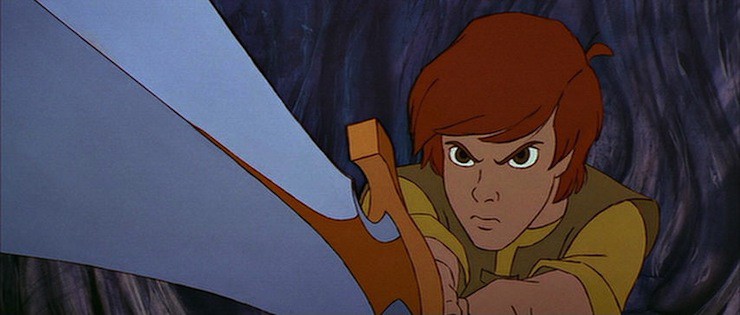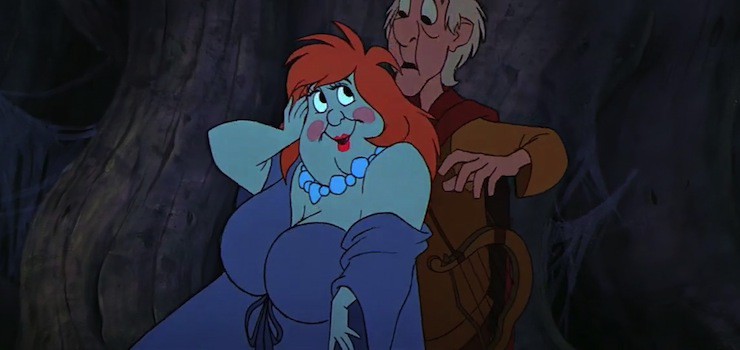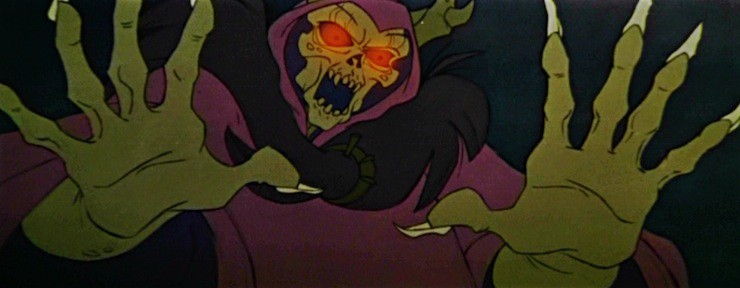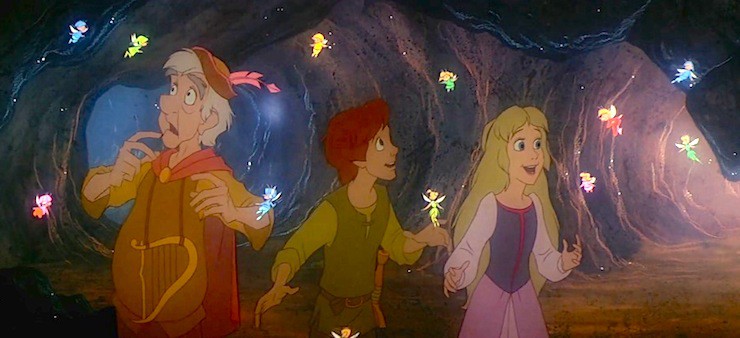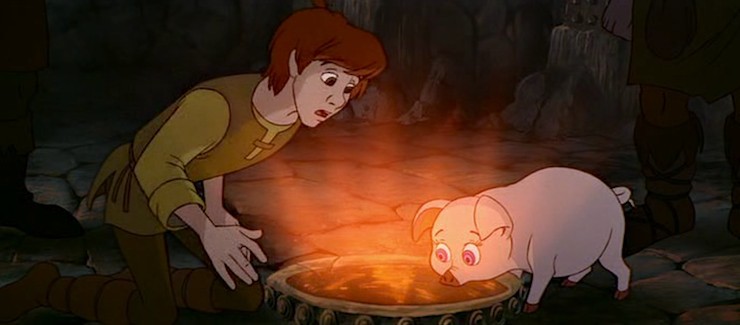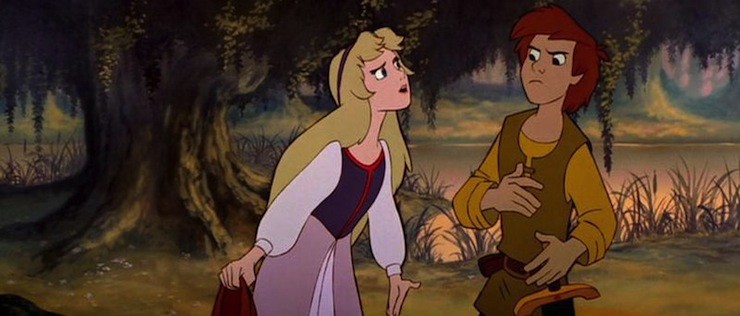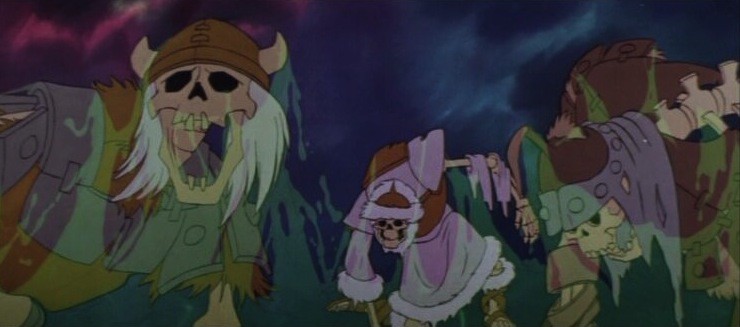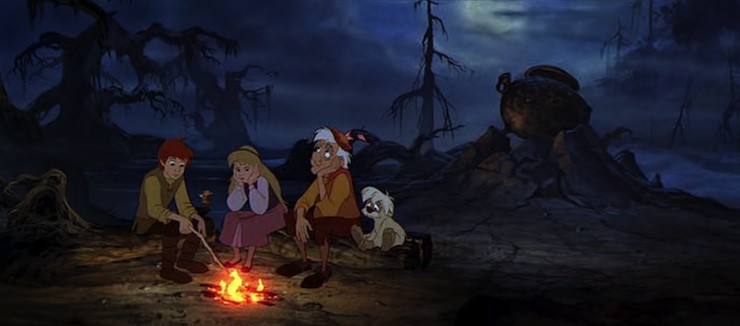Ever since Snow White, Disney had been struggling with two separate animation issues: effects sequences and the process of transferring animation art to film without going disastrously over budget. Some film tricks—using cornflakes to create something that more or less looked like snow, for instance—had helped with the first, and the xerographic process introduced in One Hundred and One Dalmatians had been a lifesaver for recent film budgets. But some of those techniques also caused problems: the cornflake technique could often be tricky to film, and the xerographic process generally resulted in characters outlined with thick black lines, and limited the ability of animators to add the subtle color shadings that had been featured in Pinocchio and Fantasia.
But in the 1980s, something new and miraculous entered the picture: computers. They could, animators thought, solve multiple issues: the transfer process; effects shots (Disney animators had been thrilled by the computer animation created by Pixar for Star Trek II: The Wrath of Khan); and even—possibly—filming. They decided to try to insert computer generated images into their next upcoming film. And, they thought, they could also try out a new animation transfer technique, animation photo transfer (APT) for a few scenes.
Unfortunately, audiences were introduced to both in Disney’s second all time greatest animation flop: The Black Cauldron.
Disney had optioned Lloyd Alexander’s popular, award winning novel back in 1971, and started story development in 1973. No one, however, worked much on the film until the late 1970s, with actual production starting in 1980. The film would, the animators agreed, start off on the now traditional Disney note, showing off the multiplane camera: that is, the shot where the camera peers through a large gap between trees and then moves through the trees, to give the illusion that the camera, and thus viewers, are moving into the story. After that opening, however, The Black Cauldron would be something new: focused on high fantasy instead of talking animals or fairy tales, without a single song or dance sequence, but with a level of animation not seen, animators promised, since Pinocchio and Fantasia days. (In reality, Sleeping Beauty, but even by the 1980s, that film was still a somewhat sore subject with the animation department; it would be another decade before the studio would view it with pride.) It would also, they decided, be aimed less at small children, and more at teenagers.
That teenage focus allowed animators to add a few bits that made The Black Cauldron the first Disney animated film to earn a PG rating, thanks to some scary skeleton scenes, a heavier than usual amount of cartoon violence, and a somewhat inappropriate moment with a frog hidden in a woman’s cleavage. The issue here isn’t so much a woman hiding a frog in her cleavage—I expect the MPAA would have been fine with that sort of thing—but that the frog is actually a transformed guy that the woman wants to have fun and not at all suitable for a G rating times with, which the MPAA was a bit less fine with.
Four years later, the animation department showed the final film to Roy Disney (Walt Disney’s nephew) and Jeffrey Katzenberg. It was a nervous moment for all concerned. Roy Disney and Jeffrey Katzenberg had just started their jobs a few days earlier: Katzenberg as a personal pick to head Walt Disney Pictures by new CEO Michael Eisner, who had worked with him over at Paramount, and Roy Disney, who had asked Eisner if he could head the animation department, bringing his wealth of experience to the job. The animators wanted to impress their new bosses.
In that, the animators failed.
Badly.
Roy Disney later recalled watching the film with a sinking “Oh, no, feeling,” though he was reportedly polite about it at the time. Katzenberg, however, was so horrified that, in an episode that became part of Disney legend and was still retold in awed voices decades later, he marched into an editing room with the film and began personally cutting scenes from the film. He had removed two or three minutes from the film (accounts vary) before animators, convinced that nothing in the film could be cut, dragged Eisner in to settle the issue.
Eisner wasn’t all that impressed with the final film either—although he, at least, was somewhat more tactful, telling later interviewers that the film had advanced the art of animation and was beautifully done, even if the story sucked. (I paraphrase his more nuanced observation.) He also shared the concerns that the scary scenes might be too much for young viewers, especially since a recent live action Disney release, Return to Oz, had been criticized for, among other things, being too terrifying for children. To be fair, The Black Cauldron is nowhere near as disturbing, but Eisner wanted to restore the Disney brand with friendly movies, and apart from one or two characters, “friendly” is perhaps not the best word to describe The Black Cauldron.
In the end, about twelve minutes were cut. The animators were removed from their nice, cheery building to a warehouse two miles away. Eisner faced starting his new Disney CEO career with a box office bomb. Everybody was very sad, except for film critic Roger Ebert, the one person who unabashedly loved the film, but then again, he didn’t have to work in a demoralized animation department. Tim Burton, who contributed to early work on the film, was so sad that he fled traditional animation entirely, heading off to work with live action and stop motion animation for all of his future work.
What went wrong? Well, to start with, although the animators all started with more or less the same idea, and more or less the same inspirations from Star Wars and various early 1980s fantasy films, by all reports, they generally worked in multiple, completely separate units, rarely communicating with each other. This in turn helped give the film a severely disjointed look, with characters often appearing to be designed for completely different films.
Disney had played with this idea before, of course, giving the three fairies in Sleeping Beauty a different, rounder look than other characters in the film, and giving Madame Medusa in The Rescuers a distinctly flamboyant look to set her apart. Here, however, the results were considerably more random: about all I can say for the Fair Folk, for instance, is that they share the look of “small” and “glowing”—otherwise, some resemble the ordinary, non magical characters, some the good magical characters, some the evil magical characters, some the evil non magical characters, and some nothing in particular.
The Disney executives, however, were less concerned with character design, and more worried about another aspect: story, or rather, the lack of it. Problem elements include the characters all meeting up, rather randomly, in an Evil Castle, then escaping, then going back to the Evil Castle again, and escaping, rather randomly. A magical pig more or less wanders off midway through the film and nobody really worries about her even though the entire original point was to protect the pig at all costs. The happy ending requires six characters to act completely out of character, and even allowing for the fact that they’ve all been taken over by pod people, it still makes no sense. Characters continually walk over or in some cases jump right into plot holes. At one point, Princess Eilonwy is dismissed as just a scullery maid. It’s meant, I think, to be an insult, but since the other two characters with her are correctly described as a pig keeper and a failed bard, it comes off more as brand new information for viewers.
Some of the plot holes probably came from Katzenberg’s decision to pull twelve minutes from the film, but it’s hard not to think that the reported lack of communication between the multiple separate units working on the film didn’t contribute to the problem.
The characters, too, had issues. Taran, the main protagonist, alternates between bland and whiny and back again: in his whiny stages, he is often cruel, when, that is, he isn’t dooming the world. The whininess was perhaps partly inspired by Luke Skywalker, a clear influence on the film. But where Luke’s whininess at least came from his desire to do something instead of just moping around a moisture farm, and a later desire to halt the Empire’s “We don’t really need any of those planets, do we?” march across the galaxy, Taran’s whininess, made explicit in the film, comes from a desire to have others see him as a hero. Aunt Beru and Uncle Owen die while Luke is out trying to find his droids and learning about Princess Leia and the Force; the magical pig is kidnapped while Taran is daydreaming about people applauding his heroism.
And Taran has a pretty bad habit of being hypocritical and rude. He turns on Gurgi just a few hours after they meet, calling the little creature a “miserable coward”—just because the creature isn’t exactly excited about entering a dark, gloom filled castle filled with dragons and the forces of evil. I’m with Gurgi here, Taran: that’s not cowardice, just common sense. And that’s not even considering that this scene happens just minutes after Gurgi was just brave enough to follow Taran after he was attacked by dragons, and still wants to be Taran’s friend despite the kid’s general rudeness.
The minor characters are not much better. Eilonwy is nice enough, despite a tendency to giggle too much, but bland—so bland, indeed, that she’s the one of only three Disney princess who never made it into the Disney Princess lineup. (The other two are Frozen’s Elsa and Anna who, as right now, are not “official” Disney Princesses even though they often seem to be treated as Disney Princesses and make appearances with other Disney Princesses. It’s a Disney Mystery.) That omission may have stemmed at least in part from Disney’s lack of enthusiasm for The Black Cauldron in general, or from the realization that one Disney Princess with no personality whatsoever (hi, Aurora) was enough, but it’s also quite possible that the people behind Disney Princess just forgot her. I can’t blame them; most of the time the film forgets her too. Daalben is a run of the mill elderly wizard mentor who is exactly like every other run of the mill elderly wizard mentor, except with less personality: I couldn’t help wishing that Gandalf would show up and boom, “YOU CANNOT WIZARD!” I can tolerate him only because he’s barely in the film. Fflewddur Fflam works only because he’s voiced by Nigel Hawthorne, but he’s not given much to do. The Fair Folk (in this film, not the book) are more or less Smurfs with the ability to fly, only more irritating and in more colors. The pig is, well, a pig. Gurgi is cute, but absent for much of the film, and one cute character is not enough to save a film.
What does work, oddly enough, is the relationship between Taran and Eilonwy: this is Disney’s first attempt to build a romance between two human characters, instead of presenting us with “This is a beautiful princess, and this is a beautiful prince,” and more or less leaving matters there. Taran and Eilonwy talk, exchange the occasional shy glances, and work together. It’s a romance I can buy. But, like Gurgi, this is not quite enough to save the film.
The villains were, if possible, even less memorable. John Hurt did what he could with the voicing for Skeletor I mean the Horned King—who in most scenes looks like Skeletor, except in the scenes where he looks like a less convincing Skeletor—but what he could was not much. It’s never exactly clear what Skeletor whoops Horned King is trying to accomplish in the film other than spread around vast amounts of radioactive looking green stuff and send dead people traipsing through the land: after all, he already has a castle full of living minions, who, unusually for a Disney film, seem relatively competent, and it’s not clear what else he really needs or wants. The three witches are almost ur-examples of every single negative cliché said about evil women, or women desperate for sex, and it’s not exactly clear what they’re trying to accomplish either, apart from maybe trying to make more frogs. Disney’s films had often triumphed or fell thanks to the villains, and here, I have to say the word we are looking for is “fail.”
This left only one thing to praise: the animation. In some parts of the film—notably in the final, surreal scene with the Black Cauldron bringing back the dead—this was brilliant. Animators were also able to use new colors, mixed specifically for the film, and highlighted in that Black Cauldron scene. Unfortunately, that was also a scene that Katzenberg cut, fearing it was both too scary and not particularly plot driven, so viewers didn’t get to see all of the new colors. A few scenes contained clever cartoon gags and transformations. Gurgi, however annoying, at least looks adorable in the best of the Disney tradition. And, for most of the film, the animators were able to return to their beloved, softer colored lines, mixed with slender black lines, for the inking process.
Above all, the film included the very first computer generated images in an animated Disney film: some bubbles and the cauldron itself were created with the help of a computer.
And then there’s the rest of the animation, which, to be kind, varies. The first ten minutes had genuinely sloppy animation, of the sort not seen since Snow White, with various animation cels actually missing. This sloppy animation had taken up about ten seconds of Disney’s first landmark feature: it takes up ten minutes here, inexcusable in a film created in the 1980s. At several points, the dirt cheap and generally lousy animation for He-Man is at least cleaner, and arguably better.
Note: the later DVD release cleaned up some of this, as well as providing an ok, if not great, transfer, but you can still see several of the animation issues—which become even clearer if you see the film, as I originally did for this ReadWatch, through Amazon.com’s streaming service. Fond though I am of blaming Amazon for most problems in life, in this particular case, I really can’t blame Amazon for the obviously missing animation cels which cause some of the characters to shimmer or jump, or the scenes where colors are bleeding outside of the lines. These issues don’t exist in the Amazon and Netflix transfers of other Disney flicks, but they do here, as well as in some of the scenes in the DVD release. It’s bad.
Even the best moments are often marred by the dialogue. During one of the cauldron scenes, for instance, the spectacular animation effects have to deal with this:
Eilonwy: Please, Taran! No! You can’t!
Taran: My mind is made up!
Gurgi: Wait master! Gurgi not let you jump into cauldron!
Viewers: Nah, Gurgi, it’s ok. Let him jump into the cauldron.
Gurgi: Please, master, not go into evil cauldron!
All of this unconvincingly delivered, except maybe the bit from the viewers. It’s no wonder that Katzenberg, Eisner and Roy Disney regarded the final result with dismay.
Their worst fears were realized when The Black Cauldron was released in July 1985. The majority of critics—Roger Ebert aside, who was wrong here—hated it, and audiences shunned a Disney animated film with no songs, almost no jokes, and a PG rating. It was one of the greatest box office duds of 1985, earning only $22 million at the box office, against a $45 million budget, beaten at the box office not only by Back to the Future, but by a re-release of E.T. Four weeks later, Disney pulled the film from theaters and placed it deep, deep within its vault until 1998, when it was released on VHS to limited fanfare, and a later 2010 DVD.
Some viewers felt it should have remained in the vault.
Animators had hoped that The Black Cauldron would allow Disney to return to its glory days, no longer relegated to children’s entertainment. And they’d hoped that the CGI would jumpstart a new era of Disney films. (Eventually, it did, but not quite yet.) But as with The Fox and the Hound, its greatest legacy came from its production problems, which led to multiple changes. The demoralizing experience persuaded Tim Burton to give up on animation and head towards live action films. (In other words, if you hate, hate, hate Pee-Wee’s Big Adventure, Beetlejuice, Batman or any of Burton’s other works, this might be the film to blame.) And Michael Eisner ordered animators to abandon their decades-long process of developing a script from concept art and storyboards, and to use instead the more standard live action process of developing storyboards from a script, a process he hoped would bring the studio back to focusing on story.
That is, if Disney continued to make animated films at all. The studio had only managed to produce three films in one decade (Winnie the Pooh, released in 1977, mostly contained material animated earlier). Of those, only one had been a major hit, and one had been a financial disaster. The animators trained by Walt Disney had almost all retired or were about to retire. Eisner and Katzenberg felt doubtful.
Newly returned Roy Disney, however, who had been part of the investment group that had prevented a hostile takeover of Disney and brought Eisner on board—thus giving him some clout—argued that animation was still the cornerstone and the key to the entire company. Plus, the animators had also been working very hard on a second film that also contained some computer animation, due to come out very soon.
It featured two mice. A good omen.
The Great Mouse Detective, coming up next.
Mari Ness lives in central Florida.










